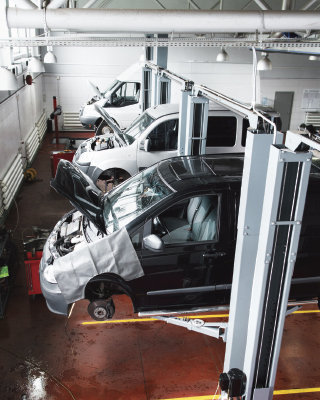In a typical year, most fleet operators would now be preparing for ordering season by determining their budget, assessing models, developing specs, and coordinating with their supply chain vendors. However, the outlook for this year’s ordering cycle is clouded with lingering uncertainty. Although disruptions are subsiding, challenges remain, and most fleets find themselves still trying to catch up after two-plus years of limited vehicle availability.
With ordering season right around the corner, it is more critical than ever to be proactive in your strategic planning and budget allocation while also ensuring you’re well prepared to adjust for unforeseen detours.
To help you craft a comprehensive supply chain strategy for the upcoming ordering cycle (and beyond), here are a few key factors to consider.
REASSESS THE STRATEGY
As the supply chain continues to rebound now’s a terrific time to take a fresh look at your overall fleet and cycling strategy. Ask yourself, how have three years of supply chain delays, limited vehicle availability, and extended life cycles affected your fleet operations through all stages of the vehicle life cycle—buy, drive, service, and sell.
With many units remaining in service longer than originally anticipated, you’ll want to ensure you develop a holistic strategy to address issues that may arise throughout each phase of the vehicle’s life cycle. You may also need to adjust your operating budget to account for variables such as increased downtime and higher maintenance.
OPTIMIZE & MAINTAIN
With some models still in limited supply, taking care of the vehicles you do have is critical. In all likelihood, your vehicles are poised to remain in service much longer than you initially anticipated and will likely require some additional TLC to keep them on the road as you await replacement units.
Start by re-examining your preventive maintenance (PM) strategy to better align with the reality that your vehicles will be logging more miles, incurring additional wear, and stretching their life cycle well beyond their original forecast. With life cycles extended, you’ll also want to review the services included in your PM schedules and, if necessary, add important services that typically occur later in a unit’s life cycle. Additionally, make sure you use full-service repair facilities (rather than quick lube locations) that perform a multi-point vehicle inspection to help identify potential issues early and avoid catastrophic component failures.
BUDGET ACCORDINGLY
Unfortunately, there’s no way around it. The reality is that the vehicles you order today are going to cost more than your last ordering cycle. Acquisition costs are up across virtually every segment of the industry. This sentiment holds true for the upfit sector as well amidst an uptick in commodity (aluminum, steel, etc.) and component pricing.
Given those factors, you’ll want to be proactive in your planning and budget allocation to ensure you’re well positioned for this ordering cycle. Also keep in mind the window for ordering may be volatile and you may need to reallocate funding quickly to meet a particular deadline. Maintain an open dialogue with your finance team and have a variety of options in place so you’re ready to adjust accordingly.
Rather than simply planning for the year ahead, most fleet operators will benefit from a more macro approach. If you’re able to forecast three to five years out, you’ll have greater financial flexibility to adjust to unforeseen challenges or have capital available to take advantage of cost-savings opportunities that may arise.
PROACTIVELY PLAN
While lead times and production delays aren’t as significant as they were last year, you still need to expect—and plan accordingly for—longer lead times. A good rule of thumb is to anticipate a minimum of six months to receive your vehicles. Additionally, some order cancellations are unavoidable, so you’ll want to have contingency plans in place to minimize the impact on your business.

EMBRACE EVs
As organizations prioritize corporate social responsibility, a growing number of businesses are exploring a variety of sustainability initiatives. This often means fleet operators find themselves evaluating the feasibility of electric vehicles (EVs), hybrids, and other alternative fuel options to align with your company’s overall sustainability strategy.
As you examine your supply chain strategy, now may be the ideal time to determine if your organization is ready to embrace EVs. While the transition to electric vehicles won’t happen overnight, many businesses are ready to begin integrating EVs into their fleet mix.
The good news is you don’t need to wait to get started. You can begin with an initial pilot program or portion of your fleet. Then, you can build on your successes by applying the insight and knowledge you gain to other segments of your fleet. Additionally, there are a variety of partners and resources available to help simplify electrification projects. By streamlining vehicle acquisition and infrastructure development, you can make integrating EVs into your fleet virtually seamless.
REMAIN AGILE
With vehicle availability still somewhat limited, flexibility and quick decision-making are incredibly important. You’ll want to be well prepared to make acquisition decisions as quickly as possible. Discuss your strategy and budget allocation with the necessary stakeholders well in advance to have the framework of your solution in place. When order banks open or a particular model becomes available, act immediately.
You’ll also want to maintain an ongoing dialogue with your supply chain partners. Strong partnerships and transparent communication will allow you to remain agile and flexible.
DIVERSIFY SUPPLY
Fostering an increasingly diverse supply chain continues to be a top strategic priority for a number of organizations. Today, your supply chain partners have to provide the services and resources your business needs to maximize revenue while also aligning with your corporate social responsibility philosophies and goals. However, as you look for ways to diversity your fleet spend—often among the largest line items in your operating budget—you’re left with limited, if any, options.
FOR MORE INFORMATION
Find out more about Holman’s holistic fleet and mobility solutions, visit www.holman.com.




